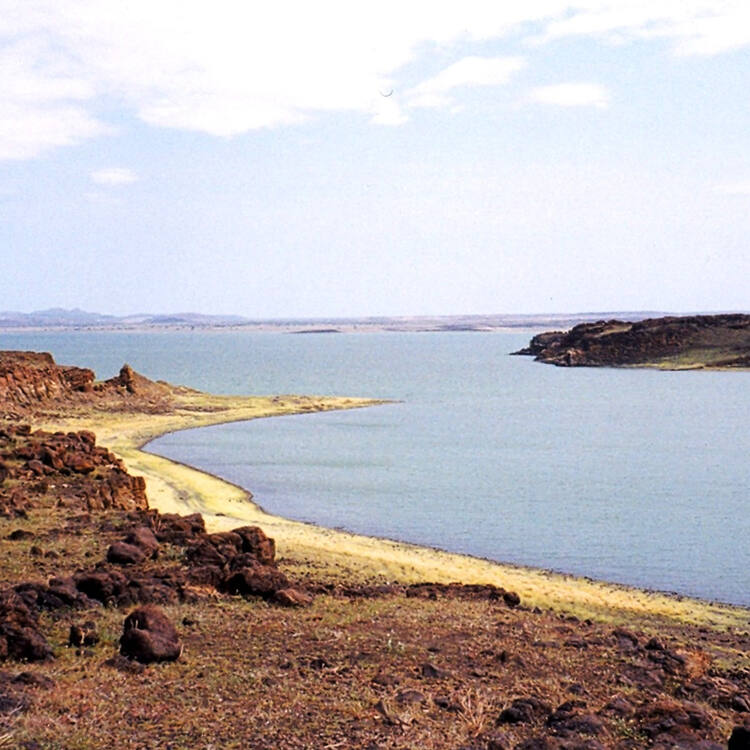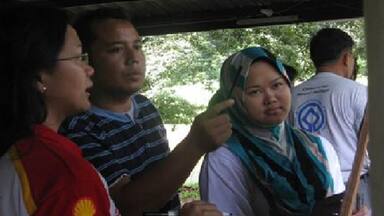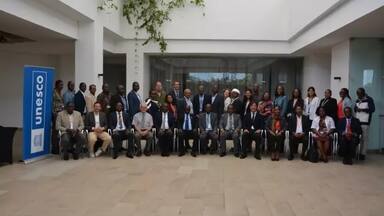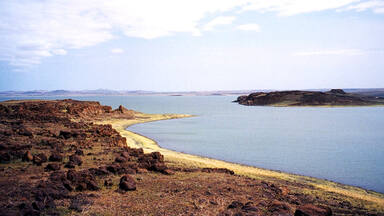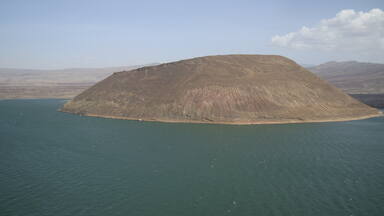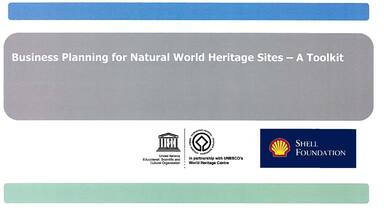Lake Turkana National Parks
Lake Turkana National Parks
The most saline of Africa's large lakes, Turkana is an outstanding laboratory for the study of plant and animal communities. The three National Parks serve as a stopover for migrant waterfowl and are major breeding grounds for the Nile crocodile, hippopotamus and a variety of venomous snakes. The Koobi Fora deposits, rich in mammalian, molluscan and other fossil remains, have contributed more to the understanding of paleo-environments than any other site on the continent.
Description is available under license CC-BY-SA IGO 3.0
Parcs nationaux du Lac Turkana
Le plus salé des grands lacs d'Afrique, le Turkana, est un laboratoire exceptionnel pour l'étude des communautés végétales et animales. Les trois parcs nationaux servent d'étapes aux oiseaux d'eau migrateurs et constituent d'importantes zones de reproduction pour le crocodile du Nil, l'hippopotame et différents serpents venimeux. Les gisements fossilifères de Koobi Fora, où l'on trouve de nombreux restes de mammifères, de mollusques et d'autres espèces, ont davantage contribué à la compréhension des paléo-environnements que tout autre site sur ce continent.
Description is available under license CC-BY-SA IGO 3.0
منتزهات بحيرة تركانا الوطنيّة
تُعتبَر تركانا، وهي البحيرة الأملح بين بحيرات أفريقيا الكبرى، مختبرًا استثنائيًّا لدراسة الأجناس النباتيّة والحيوانيّة. وتشكّل المنتزهات الوطنيّة الثلاثة محطاتٍ لعصافير المياه المُهاجرة وتُعتبر من أبرز المناطق لتزاوج تماسيح النيل وفرس النهر ومختلف الأفاعي السّامة. كما أن بقايا الأحافير في كوبي فورا حيث نجد الكثير من هياكل ثدييات وحيوانات رخويّة وأجناس أخرى، هي أكثر من ساهم في فهم التعدديّة البيئيّة في هذه القارة.
source: UNESCO/CPE
Description is available under license CC-BY-SA IGO 3.0
图尔卡纳湖国家公园
图尔卡纳湖是非洲含盐量最高的大湖,它为研究动植物种群提供了良好环境。这里的三个国家公园既是迁徙水鸟的中途停留地,也是尼罗河鳄鱼、河马和各种毒蛇的栖息地。在图尔卡纳湖畔发现的库比·福勒化石遗迹中发掘出了许多哺乳动物、软体动物和其他动物的化石,它对于研究理解古代自然环境所作的贡献是非洲任何其他地方无法比拟的。
source: UNESCO/CPE
Description is available under license CC-BY-SA IGO 3.0
Национальные парки на озере Туркана
Озеро Туркана (Рудольф), самое соленое из всех крупных африканских озер, является естественной лабораторией для изучения сообществ растений и животных. Три национальных парка, располагающихся по берегам и на островах этого озера, служат местом остановки для мигрирующих птиц и являются «родильным домом» для нильских крокодилов, бегемотов и различных ядовитых змей. Обнаруженные в районе Кооби-Фора ископаемые остатки гоминид, млекопитающих, моллюсков и т.д., имеют огромное значение с точки зрения палеогеографии.
source: UNESCO/CPE
Description is available under license CC-BY-SA IGO 3.0
Parques nacionales del Lago Turkana
El lago Turkana es el más salino de los grandes lagos de África y constituye un laboratorio excepcional para el estudio de diferentes comunidades de plantas y animales. Formado por tres parques nacionales, este sitio sirve de etapa a las aves acuáticas migratorias y es un área de reproducción importante para especies como el cocodrilo del Nilo, el hipopótamo y diversas serpientes venenosas. Los yacimientos fosilíferos de Koobi Fora –donde se conservan numerosos restos de mamíferos, moluscos y otras especies– han contribuido más al conocimiento de los paleoambientes que ningún otro sitio análogo del continente africano.
source: UNESCO/CPE
Description is available under license CC-BY-SA IGO 3.0
トゥルカナ湖国立公園群
シビロイ国立公園はケニア北部のトゥルカナ湖東岸に位置する。多様な野鳥の生活と砂漠の環境と相まって、トゥカナ湖の生態系は共生する動植物研究の格好の実験室である。この湖はまたナイルワニの繁殖地としてアフリカで最も重要な地位域であるとともに、第四紀のトゥルカナ湖盆地の古環境を研究する上で重要な哺乳類化石の産地でもある。source: NFUAJ
Nationale parken Turkana meer
Het Turkana meer is het meest zout van alle grote meren in Afrika, hierdoor is het een goed onderzoeksgebied om planten en dieren te bestuderen. De drie Nationale parken rond het meer worden gebruikt als tussenstop voor migrerende watervogels en zijn belangrijke broedplaatsen voor de Nijlkrokodil, nijlpaarden en een verscheidenheid aan giftige slangen. De Koobi Fora vindplaatsen zijn rijk aan zoogdieren, weekdieren en andere fossiele resten. Ze hebben meer kennis opgeleverd over paleo-omgevingen dan enig ander gebied op het continent. In de nationale parken komen ook zoogdieren voor, waaronder de zebra, gazelle, leeuw en cheetah. Verder zijn hier meer dan 350 vogelsoorten te vinden.
Source: unesco.nl
Outstanding Universal Value
Brief synthesis
Lake Turkana National Parks are constituted of Sibiloi National Park, the South Island and the Central Island National Parks, covering a total area of 161,485 hectares located within the Lake Turkana basin whose total surface area is 7 million ha. The Lake is the most saline lake in East Africa and the largest desert lake in the world, surrounded by an arid, seemingly extraterrestrial landscape that is often devoid of life. The long body of Lake Turkana drops down along the Rift Valley from the Ethiopian border, extending 249 kilometers from north to south and 44 km at its widest point with a depth of 30 meters. It is Africa's fourth largest lake, fondly called the Jade Sea because of its breathtaking color.
The property represents unique geo-morphological features with fossil deposits on sedimentary formations as well as one hundred identified archaeological and paleontological sites. There are numerous volcanic overflows with petrified forests. The existing ecological conditions provide habitats for maintaining diverse flora and fauna.
At Kobi Fora to the north of Allia Bay, extensive paleontological finds have been made, starting in 1969, with the discovery of Paranthropus boisei. The discovery of Homo habilis thereafter is evidence of the existence of a relatively intelligent hominid two million years ago and reflect the change in climate from moist forest grassland when the now petrified forest were growing to the present hot desert. The human and pre-human fossils include the remains of five species, Austrolophithecus anamensis, Homo habilis/rudolfensis, Paranthropus boisei, Homo erectus and Homo sapiens all found within one locality. These discoveries are important for understanding the evolutionary history of the human species.
The island parks are the breeding habitats of the Nile crocodile Crocodylus niloticus, the hippopotamus amphibious and several snake species. The lake is an important flyway passage and stopover for palaeartic migrant birds.
Criterion (viii): The geology and fossil record represents major stages of earth history including records of life represented by hominid discoveries, presence of recent geological process represented by volcanic erosional and sedimentary land forms. This property’s main geological features stem from the Pliocene and Holocene periods (4million to 10,000 years old). It has been very valuable in the reconstruction of the paleo-environment of the entire Lake Turkana Basin. The Kobi Fora deposits contain pre-human, mammalian, molluscan and other fossil remains and have contributed more to the understanding of human ancestry and paleo-environment than any other site in the world.
Criterion (x): The property features diverse habitats resulting from ecological changes over time and ranging from terrestrial and aquatic, desert to grasslands and is inhabited by diverse fauna. In situ conservation within the protected areas includes threatened species particularly the reticulated giraffe, lions and gravy zebras and has over 350 recorded species of aquatic and terrestrial birds. The island parks are the breeding habitats of the Nile crocodile, Crocodylus niloticus, the hippopotamus amphibious and several snake species. Furthermore, the lake is an important flyway passage and stopover for palaeartic migrant birds, with the South Island Park also being designated as an important bird area under Birdlife International. The protected area around Lake Turkana provides a large and valuable laboratory for the study of plant and animal communities.
Remoteness has preserved the area as a natural wilderness. On the grassy plains yellow speargrass Imperata cylindrica, Commiphora sp., Acacia tortilis, and other acacia species predominate along with A. elatior, desert date Balanites aegyptiaca and doum palm Hyphaene coriacea in sparse gallery woodlands. Salvadora persica bush is found on Central and South Islands. The muddy bays of South Island have extensive submerged beds of Potamogeton pectinatus which shelter spawning fish. The principal emergent macrophytes in the seasonally exposed shallows are the grasses Paspalidium geminatum and Sporobolus spicatus.
Integrity
The property covers a total area of 161,485 ha. The area around the property is sparsely populated due to its isolated location, inadequate freshwater and national protection status. It is an important habitat for hippopotamus and the world’s largest colony of crocodiles (and the largest Nile crocodile breeding ground in the world). Physical evidence through scientific studies indicate the area’s continued support for habitation of flora and fauna of diverse species over millions of years to the present. In addition, volcanic eruptions and extensive lava flows, geological faulting within the Great Rift Valley, and the formation of sedimentary deposits have assured preservation of fossil remains, which are significant in understanding the history of life especially human evolution. The adjacent Mount Kulal Biosphere Reserve serves as a water shed for the Lake Turkana Basin and as a wildlife dispersal area. It thereby assures the protection of the biological and natural processes making it an important site for avian habitation and migration, particularly water birds.
The area is managed under two State Acts ensuring protection, conservation and sustainability of the environment and addressing for example. post-archaeological excavation, illegal grazing, poaching and over fishing.
Protection and management requirements
The property enjoys the highest level of legal protection by both the Kenya Wildlife Act cap 376 as well as the Antiquities and Monument Act cap 215 (currently the National Museums and Heritage Act of 2006) under Kenyan legislation. Sibiloi National Park was legally designated as a national park in 1973 whereas South and Central Islands were legally designated in 1983 and 1985 respectively. The property is co-managed by Kenya Wildlife Service (KWS) and the National Museums of Kenya (NMK).
Following the extension of the property in 2001, a first management plan was developed for the period of 2001 to 2005. The long term planning foresees the development of an integrated management plan for the area. Formalization of the existing collaboration between KWS and NMK and other stakeholders through a Memorandum of Understanding will be necessary for the successful implementation of the plan.
Challenges and potential threats have been identified: these include severe droughts, livestock encroachment into the property, impacts from climate change, poaching, siltation, receding water level, human-wildlife conflicts and poor infrastructure in the area. Mitigation measures and strategies are required for the sustainable long-term management of the property and the development of an integrated management plan taking into account reforestation, law enforcement, education and awareness-raising, alternative livelihoods, resource mobilization and appropriate forms of infrastructure development (roads, electricity, telecommunication, etc.).
